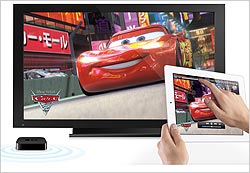Apple TV To Capture 32% Share Of Connected TV Players
- by Steve Smith @popeyesm, December 13, 2011
 The $99 Apple TV set-top box, which the late Steve Jobs once characterized as a mere “hobby” for the company, could emerge as an important component in
Apple’s future plans to dominate living rooms.
The $99 Apple TV set-top box, which the late Steve Jobs once characterized as a mere “hobby” for the company, could emerge as an important component in
Apple’s future plans to dominate living rooms.
According to a new survey and projections by Strategy Analytics, the connected TV player will sell 4 million units this year to capture 32% of the streaming media player market. The media player market includes competitors such as the Roku and Boxee boxes.
The market research firm finds that 8% of U.S. households currently own a connected media player, while 7% of European households do as well. It projects that some 12 million connected TV players will be sold this year.
The penetration of Apple TV into the living-room market has implications for Apple’s much larger business in the mobile phone and tablet world, given the ways its iOS devices also interact with Apple TV.
The iPhone and iPad can serve as remote controls for the set-top box. But more importantly, the AirPlay feature in iOS allows the mobile devices to move media to the TV from the devices and allows the iPhone or iPad to serve as complementary screens.
With the iOS5 update to the mobile platform, AirPlay has enhanced capabilities, including a mirroring function that displays the device’s screen on the TV via Apple TV. In its more advanced forms in games, especially AirPlay, the device is turned into a game controller or game map. AirPlay has also been licensed to some third-party home theater audio systems to allow music streaming from an iOS device into the amplifier.
According to Strategy Analytics Senior Analyst Jia Wu, Apple TV owners are also heavy media buyers. About 30% of these users rented movies or TV shows, while only 20% did so on other devices. Apple TV taps directly into the iTunes media ecosystem for seamless rentals and purchases.
With the addition of iCloud services, films and TV episodes that are acquired from iTunes on other devices and the desktop are also available to the Apple TV user. Rumors persist that Apple is planning to launch its own smart TV later this year with built-in connectivity to the iTunes ecosystem. Wu states in the report: “As Apple prepares for its expected launch of smart TVs in 2012, rival platforms must accelerate their development plans to keep Apple from running away with the connected TV business, as it has done with smartphones and digital music.”
Dedicated media streaming boxes are not the only contenders for American living rooms.
As Wu tells Online Media Daily, “Smart TV and connected TV sales are outpacing TV set-top boxes.” TV manufacturers are selling most mid- to upper-level televisions with connectivity and apps built-in. At the same time, both Xbox and PlayStation 3 game consoles have enormous penetration in U.S. households, and both boxes also include popular services, such as Netflix and Hulu, as well as film and TV rentals.
“They are the No. 1 platform in the U.S. in terms of getting Internet video content to TVs,” says Wu. “More consumers use it than connect their PCs to TVs via HDMI.”
In November, Strategy Analytics said that 12% of U.S. households (15 million) now stream video to their TVs via Xbox 360 or PS3.
Microsoft is also thinking along the same lines as Apple, in terms of tying video and gaming experiences on TVs with mobile devices. The company recently upgraded its Xbox 360 dashboard to include more upcoming TV services. Microsoft is also using smartphone apps to connect to its box. An Xbox Live app appeared recently for Windows Phones as well as iOS.
Despite a lead in dedicated streaming media boxes, Apple faces multiple contenders in the living-room wars. “This market is still in the early stage,” says Wu. “Apple’s leading position now cannot guarantee they can win in the smart TV market next year.”


